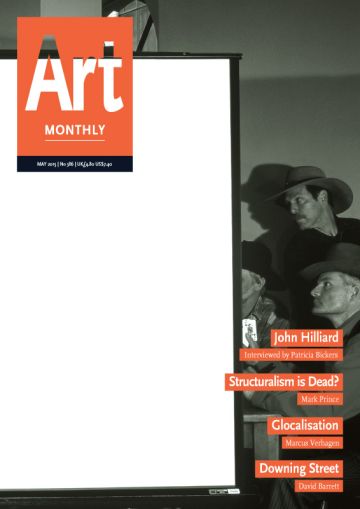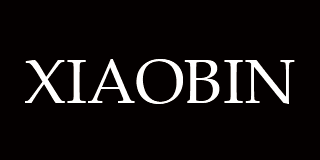Art Monthly 386
May 2015
John Hilliard
Interviewed by Patricia Bickers
Structuralism is Dead?
Mark Prince
Glocalisation
Marcus Verhagen
Downing Street
David Barrett
Buy Now – select:
Want to read this right now?
Get instant access to the entire back catalogue via Exact Editions from only £8.99!
Contents
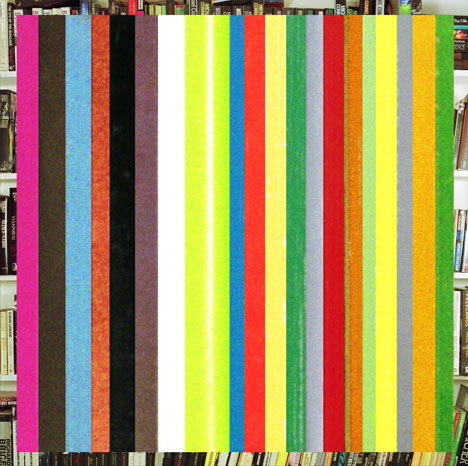
John Hilliard Cover Stories 2014
Interview
Cover Stories
John Hilliard interviewed by Patricia Bickers
John Hilliard's photographic work was instrumental to the development of British conceptual art in the late 1960s and his evolving practice has remained highly influential ever since. Here he talks about Modernism, pragmatism and aggression in photography.
'One of my favourite quotes is from Jean-Luc Godard, speaking about film: that what is important isn't the representation of reality, but the reality of representations. I am always very aware of that. Whatever your purpose, it is what you end up with – and the reality of that – that is important. That is what one has to deal with.'
From the Back Catalogue
The Truth About Photography Sarah James argues that it is time to re-examine some fundamental issues
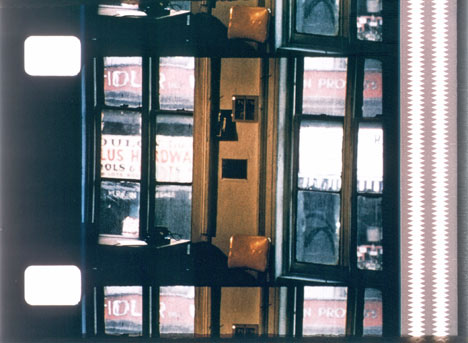
Michael Snow Wavelength 1967 film
Feature
Structuralism is Dead?
Mark Prince finds reports of its death are premature
If structuralist filmmakers of the late 1960s used the materiality of film to deny fictional narrative, how is a new generation of artists such as Liz Deschenes, Stephen Pippin and Emily Wardill utilising those same structuralist conceits as generators of narrative?
'As analogue photographic structure is digitally simplified, structural conceits become lenses through which to project narratives coloured by the constraints of a technology which no longer pertains.'
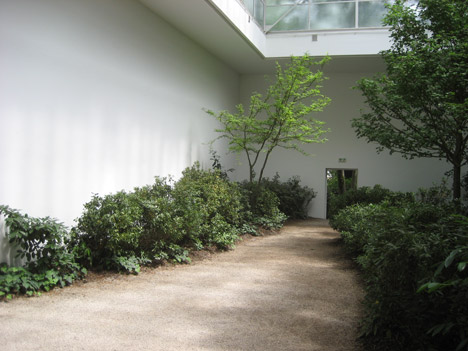
Roman Ondák Loop 2009 installation at Venice Biennale
Feature
Glocalisation
Marcus Verhagen on site-specificity and the biennale
The view that site-specific artworks can resist the mobility of global capital naively ignores the fact that places themselves are connected through myriad international networks. So how have artists such as Teresa Margolles, Roman Ondák and Wael Shawky embraced the unlikely site of the biennale as a locus for such networks?
'When Lewis Biggs intimates that site-specificity, or "context-sensitivity" as he terms it, serves as a potent defence against "bland 'internationalism'", he is placing in opposition terms that are in fact compatible: today the local is thoroughly penetrated by the global.'
Comment
Editorial
Situations Vacant
A number of high-profile museum directors have elected to step down before the coming general election. Is this because they have looked to the horizon and found nothing but stormy weather ahead?
"It feels like the end of an era because all those stepping down came to prominence when public funding of the arts, through the agency of the Arts Council, and the related notion of public service, were givens."
Artnotes
Protesting students occupy a number of universities, including Central Saint Martins and Goldsmiths; artists gear up for the general election; Hull City Council hives off its entire culture and leisure assets and activities to a new wholly owned company; a new public sculpture trail launches in east London; an unofficial bust of NSA whistleblower Edward Snowden is installed by guerrilla artists in New York, then returns in ghost form after officials remove it; the latest news on galleries, events, appointments, prizes and more.
Obituaries
Albert Irvin 1922-2015
Stuart Croft 1970-2015
Submissions: Send news items to artnotes@artmonthly.co.uk

Marco Poloni Displacement Island 2006 detail from 'La Mer au Milieu des Terres / Mare Medi Terraneum'
Exhibitions
La Mer au Milieu des Terres / Mare Medi Terraneum
Es Baluard Museu d'Art Modern i Contemporani de Palma
Virginia Whiles
Five Issues of Studio International
Raven Row, London
JJ Charlesworth
Encounters and Collisions
Nottingham Contemporary
Cherry Smyth
Michelle Stuart: Trace Memory – Selected Works 1969-2015
Parafin, London
Christopher Townsend
Columbidae
Cell Project Space, London
Galit Mana
Devotions
MOT, London
Lizzie Homersham
Li Binyuan: Social Behaviours
Centre for Chinese Contemporary Art, Manchester
Bob Dickinson
Nicky Hamlyn: Zoetrope
London Gallery West
Sophia Phoca
Newcastle and Gateshead Round-up
Drop City • NewBridge Project • Hatton Gallery • Workplace
George Vasey
London Round-up
IMT • Copperfield • Tintype • Sprüth Magers
Paul Carey-Kent
Reviews
Performance
Eva Weinmayr: Downing Street
David Barrett on an artist's response to the PM liking her work
'The audience questions the increasing absurdity of the play and argues with both the characters and the actors before different versions of the play are suggested, which leads to debate over the political agency of art and, eventually, to an agreement to return to how the play was meant to end, just to see it through.'
New Art Spaces: Open House
Eleanor Clayton on a temporary venue's blow-out finale
'After a triumphant year of extensive programming, the initial five-year tenancy agreement has come to a swift end as other tenants have been found for the building. To celebrate their successes, "Open House" offered the chance for many artists supported by the programme to showcase work in a last, somewhat chaotic, hurrah of performance, film and exhibitions across all floors.'
Reviews
Books
Eddie Chambers: Black Artists in British Art
Jonathan Harris finds a struggle at the heart of this art history
'The great strength of Black Artists in British Art is its lack of a party line and an optimistic preparedness to manifest the tensions and contradictions that characterise the history of black artists' attempts to find a place in, or to displace themselves from, the British art establishment.'
Anthony Gardner: Politically Unbecoming – Postsocialist Art Against Democracy
John Douglas Millar sees through the promise of democracy
'The problem for the architects of the neoliberal consensus in the countries of the former Eastern Bloc, however, has been that there democracy seems just another political ideology, particularly because ever since the Berlin Wall was torn down in 1989, democracy has largely been the handsome visage behind which lay the ravages of that same rampant neoliberalism.'
Listings
Events
London Art Calendar
The updated events and exhibitions calendar can also be viewed online.
Submissions: Send event info to calendar@artmonthly.co.uk
Exhibitions
Exhibition Listings
Art Monthly's exhibition listings can be viewed online.

